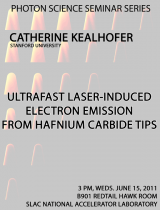Speaker: Catherine Kealhofer, Stanford
Program Description
Field emission tips naturally lead to small electron source sizes and therefore low emittance, making them ideal sources for experiments requiring coherence, small electron spot sizes, or well-collimated electron beams. The nanometric size of field emission tips also leads to optical field enhancement, so that large optical fields can be obtained at the tip apex using a simple, high repetition rate laser oscillator. By using ultrafast laser pulses to trigger electron emission from sharp tips, it is possible to combine the advantages of field emission sources with ultrafast timing precision.
Studies in several groups so far have focused on the emission process, with explorations of strong field physics in solid state systems and experiments using the electron emission to map the optical near field induced by the tip itself or in nearby nanostructures.
The first part of the talk will discuss two-photon emission from Hafnium Carbide tips. The transition metal carbides have been of some interest for laser-induced emission experiments because of their low work function, leading to relaxed requirements on the laser intensity (which might be useful for miniaturized applications), and demonstrated stable high current density emission in DC operation.
However, they have an order of magnitude lower thermal conductivity than gold or tungsten tips which have been used thus far, making them more prone to thermal effects. Two-photon emission has been identified as the dominant prompt emission process in Hafnium Carbide, but significant thermally-enhanced field emission due to laser heating of the tip is also observed. The competition between these two processes puts limits on the operation of such electron sources.
The second part of the talk will present recent work towards a tabletop ultrafast x-ray source based on the ultrafast electron emission from a tip placed in a transmission x-ray tube. Besides uses studying ultrafast dynamics, such a source could be used to reduce backscatter backgrounds in medical imaging.





